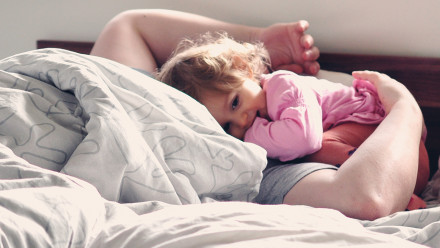Your child may be ready to lose his snooze. But are you?

Photo: iStockphoto
Kelly Sturtevant tried everything to get daughter Keira to nap. She’d lie with her, read another story, sing yet another song. But the rambunctious 2½-year-old refused to nod off. “I would spend the entire time running up trying to get her to fall asleep or yelling at her for getting out of bed,” said the 32-year-old Calgary mom of two. “After two hours, I was so flustered that I spent the rest of the day just angry that she hadn’t slept.”
Naps serve a key function for young kids. “Sleep is important for learning, memory and growth,” says Alyson Shaw, a paediatric consultant at the Children’s Hospital of Eastern Ontario in Ottawa. But let’s be frank: That’s not why parents lament the day when kids outgrow naps. “Working parents, they get lunch, they get coffee breaks,” says Sturtevant. “Stay-at-home moms, we get nap time.” Sadly, not forever. Here’s how to cope when it’s time to lose the snooze.
Don’t be a slave to the calendar
While most children give up naps between ages three and five, it can be normal for kids as young as two to stop, while 10 to 12 percent of children still nap at age five, according to Manisha Witmans, director of the pediatric sleep program at Stollery Children’s Hospital in Edmonton. Expect some inconsistency during the transition. “It might be for a few weeks they’re only napping three out of seven days, and then it might be two out of seven days,” she said.
Know when to keep the sleep
If your child skips a nap, then nods off on late-afternoon walks or drives, she probably still needs her rest. Shaw suggests waking her by 4 p.m. so as not to sabotage bedtime. Monitor how your child handles days without a snooze: “If she’s cantankerous and unmanageable, then probably the nap is still needed,” says Witmans.
Expect a good fight
Lyne Grimes’s daughter was two when she started protesting her nap. When Gabrielle skips it, she’ll either fall asleep in the car when they’re out and about in Dartmouth, NS, or start “crying at the drop of a hat” around dinnertime.
According to Isabela Granic, a developmental psychology professor and co-author of Bed Timing, toddlers like Gabrielle are typical: Major cognitive changes occurring around age 18 to 24 months, and again at 36 to 42 months, can prompt some children to fight napping. “It’s not necessarily because their physical bodies have decided they don’t need it, it’s their cognitive capacity to want more autonomy and power in the relationship, to fight for stuff when they aren’t allowed to fight for almost anything,” she says.
So what do you do? A sleep-deprived child will show increased aggression, crankiness, hyperactivity, inattentiveness and a personality shift on days he doesn’t nap. “I would ramp up my efforts to try to get my child to sleep more,” Granic says. “If those signs are missing, then the child might not need to nap.”
Help a protestor sleep
 How to deal with toddler sleep regressionsIf Gabrielle starts crying in bed, Grimes or her husband soothe her with a quiet voice. “We’ll say, ‘Now sit down and put your head on your pillow’ and we’ll rub her back for 20 to 30 seconds and then leave the room,” says Grimes. Often, it works.
How to deal with toddler sleep regressionsIf Gabrielle starts crying in bed, Grimes or her husband soothe her with a quiet voice. “We’ll say, ‘Now sit down and put your head on your pillow’ and we’ll rub her back for 20 to 30 seconds and then leave the room,” says Grimes. Often, it works.
Toronto mom Katie Lawrence has braved sub-zero temperatures to get 31⁄2-year-old Gwenyth to nap in the double stroller she shares with 71⁄2-month-old sister Sophie. Lawrence says the cold weather doesn’t faze her “as long as the sidewalks are clear and I have a hat and mitts and a warm coat on.”
When Granic’s twins were dropping their nap, she played audiobooks. After five to 10 minutes, they would often quiet down and start dozing.
Accept the occasional bad day
It’s normal for a kid transitioning out of naps to have an erratic snooze pattern or an occasional afternoon meltdown. An early bedtime may stave off a crash, since most kids five and under need 10 to 12 hours of sleep.
Trade naps for quiet time
Some parents put on a movie or leave their kids in their bedrooms with books or crafts. Sturtevant fills a “quiet time box” with books and toys like an Etch-a-Sketch, puzzle and no-mess water pens. “Keira’s gung-ho about this box; she’s absolutely quiet sitting up there playing by herself,” says Sturtevant. And don’t be surprised if a child who isn’t quite over naps nods off during quiet time.
Give yourself a break
It’s normal to feel resentful when naps disappear. “It’s not because you’re a selfish mother, it’s because you actually need some downtime,” Granic says. “Parents are tired — some work 12 hours a day. Some require exercise to feel human and that’s the only time they can fit it in. Some have part-time jobs they can only get to during nap time. Some are introverts and need some alone time,” she says.
Although recapturing two hours of downtime might be optimistic, parents can still get a break. While her seven-week-old is sleeping, Leanne Loney of Val-d’Or, Que., sometimes curls up on the floor while her four- and two-year-old play around her. “I can rest a little bit,” she says.
Maintain a little consistency
While most children can adapt to napping at daycare and not at home, it’s important to provide some predictability. “If routines are changing every day, the child will give you signals,” Granic says. “If she’s tired, cranky and hyper, that’s something you’re doing wrong.” However, if that daycare snooze leaves her lying awake at night, ask about shortening the nap or substituting quiet time.
Celebrate when it’s done
Some parents find the end of nap time liberating. “At the beginning, we missed the nap, but I find we have so much more freedom,” says Alexandra Collins of St. John’s. “Now we can go swimming from one to three. We aren’t slaves to nap time anymore.”
Read more: Sleep and feeding schedules for your baby and toddler Snooze control: An age-by-age guide to naps
FILED UNDER: baby sleep Napping Preschool Sleep
Source link : https://www.todaysparent.com/kids/preschool/is-your-child-ready-to-stop-naptime












